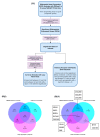Identification of Genes Whose Expression Overlaps Age Boundaries and Correlates with Risk Groups in Paediatric and Adult Acute Myeloid Leukaemia
- PMID: 32992503
- PMCID: PMC7650662
- DOI: 10.3390/cancers12102769
Identification of Genes Whose Expression Overlaps Age Boundaries and Correlates with Risk Groups in Paediatric and Adult Acute Myeloid Leukaemia
Abstract
Few studies have compared gene expression in paediatric and adult acute myeloid leukaemia (AML). In this study, we have analysed mRNA-sequencing data from two publicly accessible databases: (1) National Cancer Institute's Therapeutically Applicable Research to Generate Effective Treatments (NCI-TARGET), examining paediatric patients, and (2) The Cancer Genome Atlas (TCGA), examining adult patients with AML. With a particular focus on 144 known tumour antigens, we identified STEAP1, SAGE1, MORC4, SLC34A2 and CEACAM3 as significantly different in their expression between standard and low risk paediatric AML patient subgroups, as well as between poor and good, and intermediate and good risk adult AML patient subgroups. We found significant differences in event-free survival (EFS) in paediatric AML patients, when comparing standard and low risk subgroups, and quartile expression levels of BIRC5, MAGEF1, MELTF, STEAP1 and VGLL4. We found significant differences in EFS in adult AML patients when comparing intermediate and good, and poor and good risk adult AML patient subgroups and quartile expression levels of MORC4 and SAGE1, respectively. When examining Kyoto Encyclopedia of Genes and Genomes (KEGG) (2016) pathway data, we found that genes altered in AML were involved in key processes such as the evasion of apoptosis (BIRC5, WNT1) or the control of cell proliferation (SSX2IP, AML1-ETO). For the first time we have compared gene expression in paediatric AML patients with that of adult AML patients. This study provides unique insights into the differences and similarities in the gene expression that underlies AML, the genes that are significantly differently expressed between risk subgroups, and provides new insights into the molecular pathways involved in AML pathogenesis.
Keywords: HOX; SOX; WNT; antigen identification; mRNA-sequencing; meta-analysis; paediatric and adult acute myeloid leukaemia.
Conflict of interest statement
The authors declare no conflict of interest.
Figures



Similar articles
-
Identification of a prognostic signature based on copy number variations (CNVs) and CNV-modulated gene expression in acute myeloid leukemia.Am J Transl Res. 2021 Dec 15;13(12):13683-13696. eCollection 2021. Am J Transl Res. 2021. PMID: 35035707 Free PMC article.
-
A Direct Comparison, and Prioritisation, of the Immunotherapeutic Targets Expressed by Adult and Paediatric Acute Myeloid Leukaemia Cells: A Systematic Review and Meta-Analysis.Int J Mol Sci. 2023 Jun 2;24(11):9667. doi: 10.3390/ijms24119667. Int J Mol Sci. 2023. PMID: 37298623 Free PMC article.
-
High expression of c-kit mRNA predicts unfavorable outcome in adult patients with t(8;21) acute myeloid leukemia.PLoS One. 2015 Apr 10;10(4):e0124241. doi: 10.1371/journal.pone.0124241. eCollection 2015. PLoS One. 2015. PMID: 25860287 Free PMC article.
-
Age-associated difference in gene expression of paediatric acute myelomonocytic lineage leukaemia (FAB M4 and M5 subtypes) and its correlation with prognosis.Br J Haematol. 2009 Mar;144(6):917-29. doi: 10.1111/j.1365-2141.2008.07531.x. Epub 2008 Dec 12. Br J Haematol. 2009. PMID: 19120366
-
[Biological properties and sensitivity to induction therapy of differentiated cells expressing atypical immunophenotype in acute leukemia of children].Folia Med Cracov. 2001;42(3):5-80. Folia Med Cracov. 2001. PMID: 12353422 Review. Polish.
Cited by
-
microRNA expression in acute myeloid leukaemia: New targets for therapy?EJHaem. 2022 Apr 26;3(3):596-608. doi: 10.1002/jha2.441. eCollection 2022 Aug. EJHaem. 2022. PMID: 36051053 Free PMC article. Review.
-
Distinct noncoding RNAs and RNA binding proteins associated with high-risk pediatric and adult acute myeloid leukemias detected by regulatory network analysis.Cancer Rep (Hoboken). 2022 Oct;5(10):e1592. doi: 10.1002/cnr2.1592. Epub 2021 Dec 4. Cancer Rep (Hoboken). 2022. PMID: 34862757 Free PMC article.
-
Molecular Mechanisms and Therapies of Myeloid Leukaemia.Int J Mol Sci. 2022 Jun 2;23(11):6251. doi: 10.3390/ijms23116251. Int J Mol Sci. 2022. PMID: 35682932 Free PMC article.
-
Increasing Role of Targeted Immunotherapies in the Treatment of AML.Int J Mol Sci. 2022 Mar 18;23(6):3304. doi: 10.3390/ijms23063304. Int J Mol Sci. 2022. PMID: 35328721 Free PMC article. Review.
-
Characterization of SLC34A2 as a Potential Prognostic Marker of Oncological Diseases.Biomolecules. 2021 Dec 14;11(12):1878. doi: 10.3390/biom11121878. Biomolecules. 2021. PMID: 34944522 Free PMC article.
References
-
- Creutzig U., van den Heuvel-Eibrink M.M., Gibson B., Dworzak M.N., Adachi S., de Bont E., Harbott J., Hasle H., Johnston D., Kinoshita A., et al. Diagnosis and management of acute myeloid leukemia in children and adolescents: Recommendations from an international expert panel. Blood. 2012;120:3187–3205. doi: 10.1182/blood-2012-03-362608. - DOI - PubMed
-
- Paschka P., Marcucci G., Ruppert A.S., Mrozek K., Chen H., Kittles R.A., Vukosavljevic T., Perrotti D., Vardiman J.W., Carroll A.J., et al. Adverse prognostic significance of KIT mutations in adult acute myeloid leukemia with inv(16) and t(8;21): A Cancer and Leukemia Group B Study. J. Clin. Oncol. 2006;24:3904–3911. doi: 10.1200/JCO.2006.06.9500. - DOI - PubMed
Grants and funding
LinkOut - more resources
Full Text Sources
Miscellaneous

